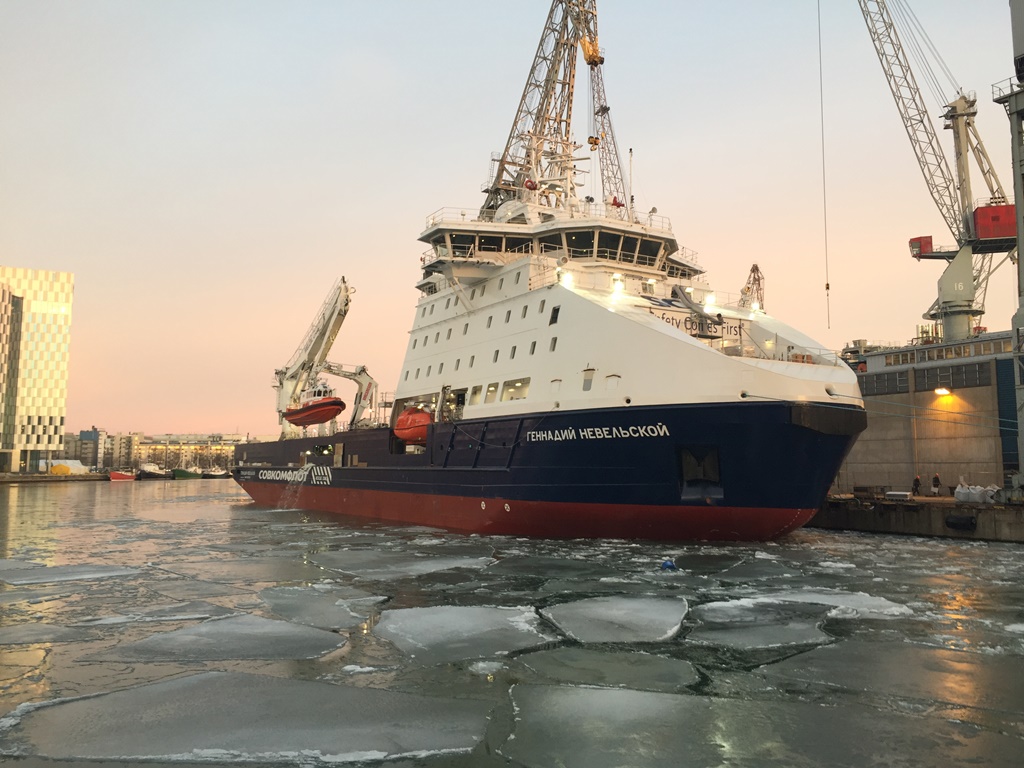New supply vessel for Sakhalin II project named Gennadiy Nevelskoy
RELEASE
News from projects and regions
On January 30, 2017, a naming ceremony was held for a new ice-breaking platform supply vessel. The ship was built to order for Sovcomflot in 2016 within the Sakhalin II project under a long-term agreement with Sakhalin Energy.
The naming ceremony was attended by Sergey Frank, President and CEO of Sovcomflot, Chairman of the Sovcomflot Executive Board, and Ole Myklestad, Production Director of Sakhalin Energy.
The ship's sponsor was Ekaterina Sokolova, research fellow with a PhD degree in Physics and Mathematics at the Center for Maritime International Studies of Admiral Nevelskoy Maritime State University (Vladivostok).
The vessel was named after Gennadiy Nevelskoy, a famous Russian navigator who had played a crucial role in the exploration of Sakhalin Island and Russia’s Far East in general. It was built using the best practices of the global shipbuilding industry and in accordance with the highest standards set for vessels operating in harsh climatic conditions.
With St. Petersburg as its home port, the Gennadiy Nevelskoy vessel will fly the Russian flag. Its deadweight is 3,000 tons. It is the first of the four vessels to be built to order for Sovcomflot within the Sakhalin II project. The other three ships are standby vessels with a smaller deadweight (2,000 tons) and advanced functionality. They can accommodate more personnel to service offshore platforms.
The Russian Maritime Register of Shipping classification society, which ensures technical supervision over the construction of the four vessels, assigned the ice class of Icebreaker 6 to the new vessel.
In 2014, Sovcomflot and Sakhalin Energy signed the 20-year service agreement for all the four vessels to be operated under the project. The vessels are intended for the year-round delivery of expendable materials to Sakhalin Energy’s three production platforms located in the Sea of Okhotsk and for standby duty near the offshore platforms. In case of emergency, the vessels will be used to ensure environmental protection and security for personnel on the platforms.
At present, Sovcomflot operates three supply vessels (SCF Endeavour, SCF Endurance, and SCF Enterprise), three Aframax crude oil shuttle tankers (Zaliv Aniva, Sakhalin Island, and Governor Farkhutdinov), and, jointly with Japan’s NYK, two LNG carriers (Grand Aniva and Grand Elena) within the Sakhalin II project. All the vessels are operated under long-term time charter contracts with Sakhalin Energy.
Background
Sakhalin Energy Investment Company Ltd. (Sakhalin Energy) is the operator of the Sakhalin II project, one of the world’s largest integrated oil and gas projects with massive oil and gas infrastructure for hydrocarbon production, transportation and processing. The company markets oil extracted from the deposits located in the Sea of Okhotsk and LNG produced at Russia’s first LNG plant built by Sakhalin Energy in the southern part of Sakhalin Island.
The project’s infrastructure includes three offshore ice-resistant platforms, the Trans-Sakhalin pipeline system encompassing 300 kilometers of offshore pipelines, an onshore gas pipeline and an onshore oil pipeline (each 800 kilometers long), an onshore processing facility, an oil export terminal, and Russia’s first (and so far only) LNG plant accounting for some 4 per cent of the global LNG output.
The main buyers of oil and LNG produced by Sakhalin Energy are Asia-Pacific countries. At present, the company exports oil to China, Japan, South Korea, Indonesia, the United States, the Philippines, and Taiwan. The main LNG buyers are Japanese, South Korean and Chinese energy companies.
The company’s shareholders are Gazprom (50 per cent plus one share), Royal Dutch Shell (27.5 per cent minus one share), Mitsui and Co. (12.5 per cent), and Mitsubishi Corporation (10 per cent).



